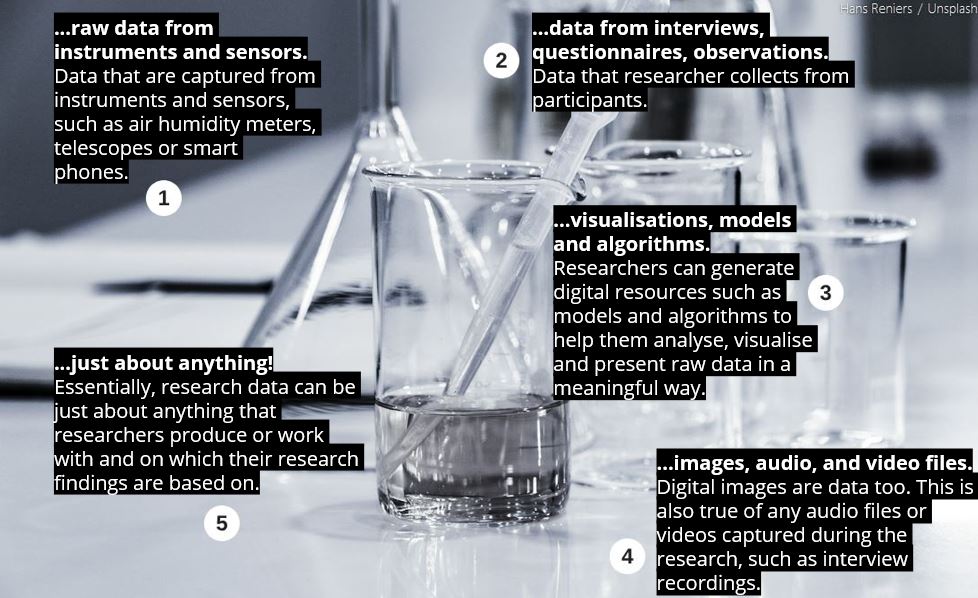Open research data
After finishing this part, you will…
- Understand the benefits and challenges of sharing research data.
- Know the principles and steps of data sharing.
- Be aware of the significance of data management planning in the context of data sharing.
- Acknowledge the importance of metadata and the FAIR principles, and why they help others to understand and reuse your data.
What are research data?
Research data are often the most valuable output of research projects. Research data can be described as any information that has been collected, observed, generated or created to validate original research findings.
Research data can include (Fig. 9):

The best practical recommendation for research data is to be as open and FAIR (Findable, Accessible, Interoperable, Reusable; see Making it FAIR) as possible, while acknowledging the ethical, commercial and privacy constraints with sensitive and proprietary data. It is also worth pointing out that currently more and more research funders expect the data produced in the research projects they finance to be findable, accessible and as open as possible.
Degrees of openness
The degrees of openness may vary from data that is freely available for everyone to strictly confidential data that only certain researchers can access. Data can also be shared to a specific group (e.g. research group) or to certain purposes, such as for research or educational purposes.
Open research data – Open research data is data that is created or collected during research process and shared publicly for reuse. Open data must be licensed to state clearly that it is openly available for reuse.
Sharing data with restrictions – Data reuse may have some conditions, such as non-commercial reuse or reuse with attribution. Data must be clearly licensed to make sure that the data reusers are aware of the conditions of reuse. In some cases, special or limited restrictions of access are set to protect the identity of human participants. Sometimes shared data is only made available to specific groups, such as other researchers and the data is available only through permits.
Research data may include sensitive information, such as personal data, sensitive personal data, sensitive species data related to endangered animals and plants, or otherwise confidential data related to patents, national defence or trade secrets. In these cases, it must be carefully considered whether it is possible to share the data and what procedures it requires. Highly sensitive data, such as sensitive personal data or otherwise confidential data, may not be possible to share at all (closed data). However, even in such cases the metadata description of the research data can usually be shared.
Ideally, open data have no restrictions on reuse or redistribution, and they are appropriately licensed. Sharing exposes data to inspection, forming the basis for research verification and reproducibility, and opens up a pathway to a wider collaboration.
Making research data openly available for others:
- Improves the extensive usability and reuse of the research results.
- Advances research and enables new observations and phenomena to be discovered.
- Provides researchers equal opportunities to utilise research data.
- Promotes research collaboration.
For a researcher, opening the data is a scientific merit. Achievements in producing and sharing research data counts as a scientific and societal impact in research work. Sharing data is worth adding to your CV (see e.g. the Research Council of Finland: CV Guidelines, Scientific and societal impact). Opening the data merits a researcher via citations to open access research data and publications produced from the research data.
Remember:
- Research data can be just about anything that researchers work with and on which their research findings are based on.
- The degrees of openness may vary from data that is freely available for everyone to that which is strictly confidential.
(8/2024 KH)
Move to the next page “Plan to share“